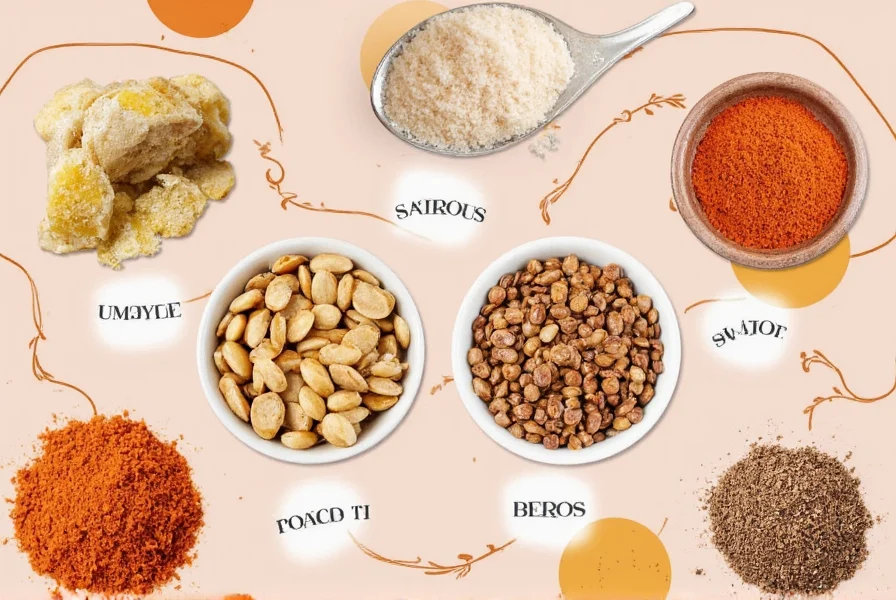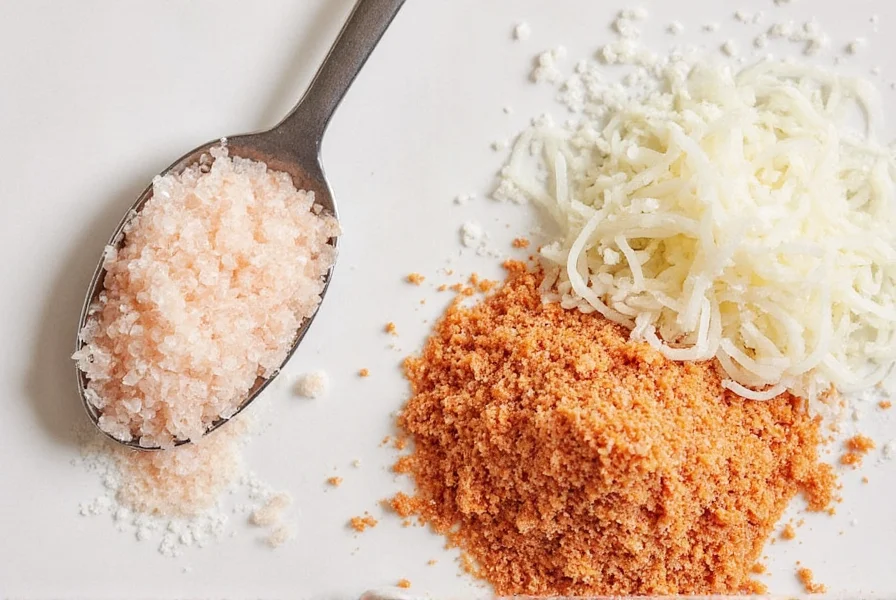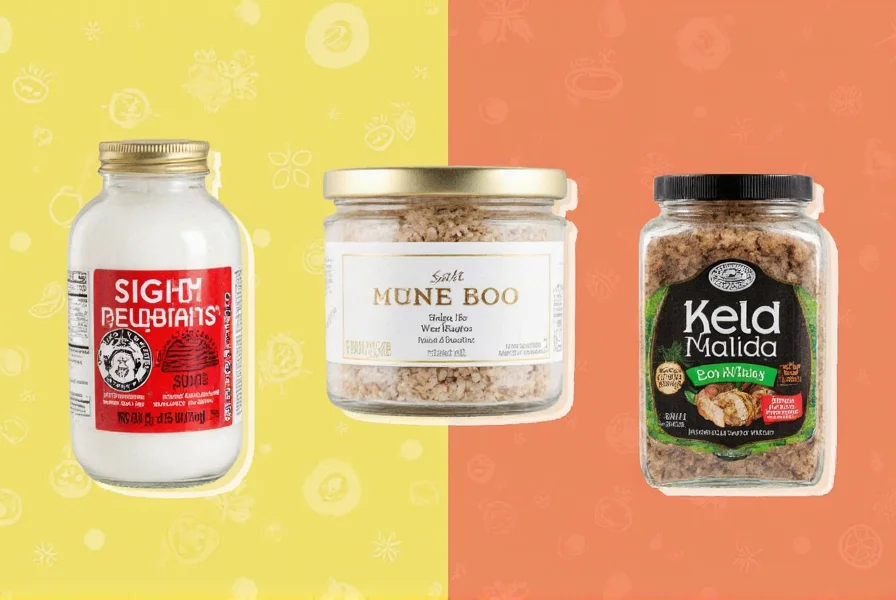| Product | Sodium Content | Flavor Profile | Best Used In | Special Notes |
|---|---|---|---|---|
| Potassium Chloride Blends | Up to 50% less sodium | Similar to table salt with slight metallic note | Everyday cooking | May have bitter aftertaste if overused |
| Lemon Juice/Zest | Zero sodium | Zesty, bright, acidic | Vegetables, fish, dressings | Adds freshness and balances richness |
| Apple Cider Vinegar | Zero sodium | Tangy, complex | Marinades, salad dressings | Enhances other flavors naturally |
| Smoked Paprika | Zero sodium | Smoky, sweet | Rubs, soups, roasted vegetables | Provides depth without sodium |
| Nutritional Yeast | Zero sodium | Cheesy, nutty | Vegan dishes, popcorn, sauces | Great dairy-free alternative |
| Garlic Powder | Zero sodium | Sharp, savory | Meats, vegetables, dips | Concentrated flavor in small amounts |
| Fresh Herbs (Basil, Thyme, Rosemary) | Zero sodium | Earthy, aromatic | Most savory dishes | Use fresh for maximum impact |
| Mustard | Low sodium | Tangy, sharp | Sandwiches, dressings, marinades | Check labels for low-sodium varieties |
Introduction: Why Choose Sodium-Free Alternatives?
When managing blood pressure or reducing sodium intake, it's crucial to distinguish between different salt types and true sodium-free alternatives. While kosher salt or Himalayan pink salt may seem like healthier options, they still contain significant sodium. True salt substitutes focus on zero or low-sodium options that enhance flavor without compromising health.
This guide provides science-backed, practical alternatives to help you reduce sodium while keeping your dishes flavorful and satisfying. Whether you're cooking for hypertension management or simply seeking healthier seasoning options, these alternatives deliver delicious results.
The Science Behind Sodium Reduction
Sodium is essential for bodily functions, but excessive intake contributes to hypertension, heart disease, and kidney problems. The American Heart Association recommends no more than 1,500mg daily for high-risk individuals. Traditional salt alternatives like potassium chloride blends offer reduced sodium while maintaining some saltiness, but true flavor enhancement comes from sodium-free options that stimulate other taste receptors.
Research shows that reducing sodium intake by 50% can significantly improve cardiovascular health when combined with flavor-enhancing alternatives. The key is understanding how different ingredients interact with our taste buds to create satisfying flavor profiles without relying on sodium.
Top 10 Sodium-Free Salt Alternatives for Healthier Cooking
- Potassium Chloride Blends: FDA-approved low-sodium alternatives with up to 50% less sodium. Ideal for everyday cooking when you need a salt-like texture.
- Lemon Juice/Zest: Zero sodium, adds bright acidity and enhances other flavors naturally. Perfect for seafood and vegetable dishes.
- Apple Cider Vinegar: Zero sodium, complex tangy flavor that balances richness in dressings and marinades.
- Smoked Paprika: Zero sodium, delivers deep smoky notes without salt. Great for rubs and roasted vegetables.
- Nutritional Yeast: Zero sodium, cheesy umami flavor perfect for vegan dishes and popcorn toppings.
- Garlic Powder: Zero sodium, concentrated savory flavor that works in almost any savory dish.
- Fresh Herbs (Basil, Thyme, Rosemary): Zero sodium, aromatic complexity that elevates dishes without salt.
- Mustard: Low sodium (check labels), tangy kick for sandwiches and sauces.
- Dried Mushroom Powder: Zero sodium, intense umami for soups and sauces.
- Black Pepper & Citrus Zest Combinations: Zero sodium, creates complex flavor profiles that trick the brain into perceiving saltiness.
When to Use Which Sodium-Free Alternative
- For Grilled Meats: Garlic powder and smoked paprika rubs create flavorful crusts without sodium.
- For Roasted Vegetables: Lemon zest and fresh herbs add brightness while preserving natural sweetness.
- For Soups & Stews: Mushroom powder and nutritional yeast provide deep umami without added sodium.
- For Baking: Use lemon zest in breads and cookies for natural sweetness enhancement.
- For Everyday Seasoning: Potassium chloride blends work best for consistent salt-like seasoning in dishes like pasta sauces.
Buying Guide: What to Look For in Sodium-Free Alternatives
- Purpose: Determine if you need a direct salt replacement (potassium chloride) or flavor enhancers (herbs, acids).
- Sodium Content: Check labels for "zero sodium" or "low sodium" claims. Avoid products with hidden sodium sources.
- Flavor Impact: Consider whether the alternative adds its own distinct flavor or simply enhances existing tastes.
- Texture: Fine powders work for even seasoning, while whole spices provide texture in rubs.
- Price: Fresh herbs and spices are cost-effective for everyday use; specialty blends may be worth the investment for specific dishes.
Featured Products
- NoSalt Original: Potassium chloride blend with 50% less sodium. Best for everyday cooking where salt texture is needed.
- Simply Organic Smoked Paprika: Pure zero-sodium spice with rich smoky flavor.
- Red Boat Fish Sauce (Low-Sodium): For Asian dishes, use sparingly for umami without excessive sodium.
- Frontier Co-op Nutritional Yeast: Vegan-friendly, zero-sodium cheesy flavor enhancer.
- Monte Alban Lemon Pepper: Zero-sodium blend of lemon zest and black pepper for seafood and salads.

Recipes to Try with Sodium-Free Alternatives
- Roasted Carrots with Lemon Zest & Thyme: Toss carrots with olive oil, lemon zest, fresh thyme, and black pepper before roasting. No salt needed!
- Smoked Paprika Rubbed Chicken: Mix smoked paprika, garlic powder, and cumin for a flavorful dry rub. Grill or bake without salt.
- Mushroom & Nutritional Yeast Soup: Blend sautéed mushrooms with vegetable broth, nutritional yeast, and fresh herbs for creamy, salty-free comfort food.
- Zero-Sodium Caesar Salad: Use anchovy-free dressing with lemon juice, garlic, mustard, and nutritional yeast for classic Caesar flavor without sodium.
- Herb-Infused Roasted Potatoes: Toss potatoes with rosemary, thyme, and black pepper before roasting for crispy, flavorful results.
Frequently Asked Questions About Sodium-Free Alternatives
- What's the best sodium-free salt substitute for high blood pressure?
- For hypertension management, potassium chloride blends (like NoSalt) are medically recommended when approved by your doctor. However, sodium-free options like lemon juice, vinegar, and fresh herbs provide complete sodium elimination. Always consult your healthcare provider before making dietary changes, especially if you have kidney issues.
- Can I completely replace salt in all my recipes?
- Yes for most dishes, but salt plays structural roles in baking (gluten development) and preservation (curing meats). For baking, use lemon zest or vinegar to enhance sweetness without salt. For cured meats, traditional salt is necessary for safety—use sodium-free alternatives only in fresh preparations.
- Do sodium-free alternatives really taste like salt?
- No true sodium-free alternative mimics salt's exact taste. Instead, they stimulate other taste receptors to create satisfying flavor profiles. With time, your taste buds adjust, and you'll appreciate the complex flavors these alternatives provide without needing salt.
- Which salt replacement works best for baking?
- For baking, use lemon zest in sweet recipes to enhance sweetness perception. In breads, vinegar can improve texture. For savory baked goods, garlic powder and herbs work well. Avoid potassium chloride blends in baking as they can cause metallic aftertastes.
- How much of a sodium-free alternative should I use compared to salt?
- There's no direct conversion since these alternatives work differently. Start with small amounts (1/4 tsp) and adjust to taste. For acid-based alternatives like lemon juice, begin with 1/2 tsp per recipe and increase gradually.
- Are potassium-based substitutes safe for everyone?
- Potassium chloride blends are generally safe for healthy individuals but can be dangerous for those with kidney disease or on certain medications (ACE inhibitors, potassium-sparing diuretics). Always consult your doctor before using potassium-based products if you have health concerns.
- How long does it take to adjust to less salty food?
- Research shows taste buds adapt in 6-8 weeks. During this period, gradually reduce salt while increasing herbs, acids, and umami-rich ingredients. Your sensitivity to subtle flavors will increase, making sodium-free dishes more satisfying over time.
- Can I combine multiple sodium-free alternatives?
- Absolutely! Combining different alternatives creates complex flavor profiles. For example: lemon juice + garlic powder + smoked paprika for chicken, or nutritional yeast + mushroom powder + black pepper for soups. This layered approach makes sodium reduction sustainable and delicious.
Conclusion: Flavor Without Compromise
Reducing sodium doesn't mean sacrificing flavor. With science-backed sodium-free alternatives, you can create delicious, healthy dishes that support cardiovascular health. The key is understanding how different ingredients interact with your taste buds to create satisfying flavor experiences without relying on sodium.
Start by incorporating one or two alternatives into your cooking routine. Over time, you'll discover how these natural flavor enhancers transform your meals while keeping your health priorities intact. Your taste buds—and your heart—will thank you.












 浙公网安备
33010002000092号
浙公网安备
33010002000092号 浙B2-20120091-4
浙B2-20120091-4